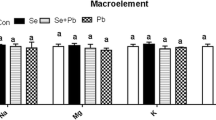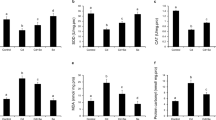Abstract
Cadmium (Cd), as one of the most toxic heavy metals, has become a widespread environmental contaminant and threats the food quality and safety. The protective effect of selenium (Se) on Cd-induced tissue lesion and cytotoxicity in chicken has been extensively reported. The objective of this study was to investigate the antagonistic effect of Se on Cd-induced damage of chicken pectoral muscles via analyzing the trace elements and amino acids profiles. Firstly, 19 trace elements contents were analyzed by inductively coupled plasma mass spectrometry (ICP-MS). The results showed that under Cd exposure, the contents of Cd, lead (Pb), mercury (Hg), aluminum (Al), and lithium (Li) were significantly elevated, and the contents of Se, iron (Fe), and chromium (Cr) were significantly reduced. However, supplementing Se significantly reversed the effects induced by Cd. Secondly, the amino acids contents were detected by L-8900 automatic amino acid analyzer. The results showed that supplementing Se increased significantly Cd-induced decrease of valine (Val), leucine (Leu), arginine (Arg), and proline (Pro). Thirdly, the results of principal component analysis (PCA) showed that cobalt (Co), manganese (Mn), silicium (Si), and Pro may play special roles in response to the process of Se antagonizes Cd-induced damage of pectoral muscles in chickens. In summary, these results indicated that different trace elements and amino acids possessed and exhibited distinct responses to suffer from Se and/or Cd in chicken pectoral muscles. Notably, Se alleviated Cd-induced adverse effects by regulating trace elements and amino acids profiles in chicken pectoral muscles.




Similar content being viewed by others
Abbreviations
- Se:
-
Selenium
- Fe:
-
Iron
- Zn:
-
Zinc
- Cu:
-
Copper
- Cr:
-
Chromium
- Co:
-
Cobalt
- Mn:
-
Manganese
- Mo:
-
Molybdenum
- Si:
-
Silicium
- Ni:
-
Nickel
- B:
-
Boron
- V:
-
Vanadium
- Cd:
-
Cadmium
- Pb:
-
Lead
- Hg:
-
Mercury
- As:
-
Arsenic
- Al:
-
Aluminum
- Sn:
-
Tin
- Li:
-
Lithium
- Sb:
-
Stibium
- Tl:
-
Thallium
- ICP-MS:
-
Inductively coupled plasma mass spectrometry
- Thr:
-
Threonine
- Val:
-
Valine
- Met:
-
Methionine
- Ile:
-
Isoleucine
- Leu:
-
Leucine
- Phe:
-
Phenylalanine
- Lys:
-
Lysine
- Asp:
-
Aspartic acid
- Ser:
-
Serine
- Glu:
-
Glutamic acid
- Gly:
-
Glycine
- Ala:
-
Alanine
- Cys:
-
Cysteine
- Tyr:
-
Tyrosine
- His:
-
Histidine
- Arg:
-
Arginine
- Pro:
-
Proline
References
Al-Waeli A, Zoidis E, Pappas AC, Demiris N, Zervas G, Fegeros K (2013) The role of organic selenium in cadmium toxicity: effects on broiler performance and health status. Animal 7:386–393. https://doi.org/10.1017/S1751731112001590
Biesalski HK (2005) Meat as a component of a healthy diet - are there any risks or benefits if meat is avoided in the diet? Meat Sci 70:509–524. https://doi.org/10.1016/j.meatsci.2004.07.017
Chen J, Xu Y, Han Q, Yao Y, Xing H, Teng X (2018a) Immunosuppression, oxidative stress, and glycometabolism disorder caused by cadmium in common carp (Cyprinus carpio L.): application of transcriptome analysis in risk assessment of environmental contaminant cadmium. J Hazard Mater 366:386–394. https://doi.org/10.1016/j.jhazmat.2018.12.014
Chen M, Li X, Fan R, Yang J, Jin X, Hamid S, Xu S (2018b) Cadmium induces BNIP3-dependent autophagy in chicken spleen by modulating miR-33-AMPK axis. Chemosphere 194:396–402. https://doi.org/10.1016/j.chemosphere.2017.12.026
Dar MI, Green ID, Naikoo MI, Khan FA, Ansari AA, Lone MI (2017) Assessment of biotransfer and bioaccumulation of cadmium, lead and zinc from fly ash amended soil in mustard-aphid-beetle food chain. Sci Total Environ 584-585:1221–1229. https://doi.org/10.1016/j.scitotenv.2017.01.186
El-Sharaky AS, Newairy AA, Badreldeen MM, Eweda SM, Sheweita SA (2007) Protective role of selenium against renal toxicity induced by cadmium in rats. Toxicology 235:185–193. https://doi.org/10.1016/j.tox.2007.03.014
Eybl V, Kotyzova D, Bludovska M (2004) The effect of curcumin on cadmium-induced oxidative damage and trace elements level in the liver of rats and mice. Toxicol Lett 151:79–85. https://doi.org/10.1016/j.toxlet.2004.02.019
Farmer AA, Farmer AM (2000) Concentrations of cadmium, lead and zinc in livestock feed and organs around a metal production centre in eastern Kazakhstan. Sci Total Environ 257:53–60
Honda R, Tawara K, Nishijo M, Nakagawa H, Tanebe K, Saito S (2003) Cadmium exposure and trace elements in human breast milk. Toxicology 186:255–259. https://doi.org/10.1016/s0300-483x(03)00002-7
Jiao X, Yang K, An Y, Teng X, Teng X (2017) Alleviation of lead-induced oxidative stress and immune damage by selenium in chicken bursa of Fabricius. Environ Sci Pollut Res Int 24:7555–7564. https://doi.org/10.1007/s11356-016-8329-y
Jihen el H, Imed M, Fatima H, Abdelhamid K (2009) Protective effects of selenium (Se) and zinc (Zn) on cadmium (Cd) toxicity in the liver of the rat: effects on the oxidative stress. Ecotoxicol Environ Saf 72:1559–1564. https://doi.org/10.1016/j.ecoenv.2008.12.006
Jin T et al (2002) Cadmium biomonitoring and renal dysfunction among a population environmentally exposed to cadmium from smelting in China (ChinaCad). Biometals 15:397
Jin X, Liu CP, Teng XH, Fu J (2016) Effects of dietary selenium against Lead toxicity are related to the ion profile in chicken muscle. Biol Trace Elem Res 172:496–503. https://doi.org/10.1007/s12011-015-0585-z
Jin X, Jia T, Liu R, Xu S (2018) The antagonistic effect of selenium on cadmium-induced apoptosis via PPAR-gamma/PI3K/Akt pathway in chicken pancreas. J Hazard Mater 357:355–362. https://doi.org/10.1016/j.jhazmat.2018.06.003
Khan K, Lu Y, Khan H, Ishtiaq M, Khan S, Waqas M, Wei L, Wang T (2013) Heavy metals in agricultural soils and crops and their health risks in Swat District, northern Pakistan. Food Chem Toxicol 58:449–458. https://doi.org/10.1016/j.fct.2013.05.014
Li JL, Jiang CY, Li S, Xu SW (2013) Cadmium induced hepatotoxicity in chickens (Gallus domesticus) and ameliorative effect by selenium. Ecotoxicol Environ Saf 96:103–109. https://doi.org/10.1016/j.ecoenv.2013.07.007
Li SW, He Y, Zhao HJ, Wang Y, Liu JJ, Shao YZ, Li JL, Sun X, Zhang LN, Xing MW (2017) Assessment of 28 trace elements and 17 amino acid levels in muscular tissues of broiler chicken (Gallus gallus) suffering from arsenic trioxide. Ecotoxicol Environ Saf 144:430–437. https://doi.org/10.1016/j.ecoenv.2017.06.061
Little PJ, Bhattacharya R, Moreyra AE, Korichneva IL (2010) Zinc and cardiovascular disease. Nutrition 26:1050–1057. https://doi.org/10.1016/j.nut.2010.03.007
Liu ZP (2003) Lead poisoning combined with cadmium in sheep and horses in the vicinity of non-ferrous metal smelters. Sci Total Environ 309:117–126. https://doi.org/10.1016/S0048-9697(03)00011-1
Liu L, Yang B, Cheng Y, Lin H (2015) Ameliorative effects of selenium on cadmium-induced oxidative stress and endoplasmic reticulum stress in the chicken kidney. Biol Trace Elem Res 167:308–319. https://doi.org/10.1007/s12011-015-0314-7
Liu F, Wang XY, Zhou XP, Liu ZP, Song XB, Wang ZY, Wang L (2017) Cadmium disrupts autophagic flux by inhibiting cytosolic Ca(2+)-dependent autophagosome-lysosome fusion in primary rat proximal tubular cells. Toxicology 383:13–23
Liu R, Jia T, Cui Y, Lin H, Li S (2018a) The protective effect of selenium on the chicken pancreas against cadmium toxicity via alleviating oxidative stress and autophagy. Biol Trace Elem Res 184:240–246. https://doi.org/10.1007/s12011-017-1186-9
Liu T, Yang T, Zhe X, Tan S, Pan T, Na W, Shu L (2018b) MicroRNA-193b-3p regulates hepatocyte apoptosis in selenium-deficient broilers by targeting MAML1. J Inorg Biochem 186:235–245
Macêdo GRD et al (2015) Trace elements distribution in hawksbill turtle ( Eretmochelys imbricata ) and green turtle ( Chelonia mydas ) tissues on the northern coast of Bahia, Brazil. Mar Pollut Bull 94:284–289
MacLachlan DJ, Budd K, Connolly J, Derrick J, Penrose L, Tobin T (2016) Arsenic, cadmium, cobalt, copper, lead, mercury, molybdenum, selenium and zinc concentrations in liver, kidney and muscle in Australian sheep. J Food Compos Anal 50:97–107. https://doi.org/10.1016/j.jfca.2016.05.015
Messaoudi I, El Heni J, Hammouda F, Said K, Kerkeni A (2009) Protective effects of selenium, zinc, or their combination on cadmium-induced oxidative stress in rat kidney. Biol Trace Elem Res 130:152–161. https://doi.org/10.1007/s12011-009-8324-y
Newairy AA, El-Sharaky AS, Badreldeen MM, Eweda SM, Sheweita SA (2007) The hepatoprotective effects of selenium against cadmium toxicity in rats. Toxicology 242:23–30. https://doi.org/10.1016/j.tox.2007.09.001
Nishimura T, Kato H (1988) Taste of free amino acids and peptides. Food Rev Int 4:175–194
Pappas AC, Zoidis E, Georgiou CA, Demiris N, Surai PF, Fegeros K (2011) Influence of organic selenium supplementation on the accumulation of toxic and essential trace elements involved in the antioxidant system of chicken. Food Addit Contam Part A Chem Anal Control Expo Risk Assess 28:446–454. https://doi.org/10.1080/19440049.2010.549152
Patsias A, Badeka AV, Savvaidis IN, Kontominas MG (2008) Combined effect of freeze chilling and MAP on quality parameters of raw chicken fillets. Food Microbiol 25:575–581. https://doi.org/10.1016/j.fm.2008.02.008
Pereira PM, Vicente AF (2013) Meat nutritional composition and nutritive role in the human diet. Meat Sci 93:586–592. https://doi.org/10.1016/j.meatsci.2012.09.018
Rayman MP (2000) The importance of selenium to human health. Lancet 356:233–241. https://doi.org/10.1016/S0140-6736(00)02490-9
Shi Q, Jin X, Fan R, Xing M, Guo J, Zhang Z, Zhang J, Xu S (2019) Cadmium-mediated miR-30a-GRP78 leads to JNK-dependent autophagy in chicken kidney. Chemosphere 215:710–715. https://doi.org/10.1016/j.chemosphere.2018.10.019
Sun B, Xing M (2016) Evaluated the twenty-six elements in the pectoral muscle of as-treated chicken by inductively coupled plasma mass spectrometry. Biol Trace Elem Res 169:359–364. https://doi.org/10.1007/s12011-015-0418-0
Sun L, Yu Y, Huang T, An P, Yu D, Yu Z, Li H, Sheng H, Cai L, Xue J, Jing M, Li Y, Lin X, Wang F (2012) Associations between ionomic profile and metabolic abnormalities in human population. PLoS One 7:e38845. https://doi.org/10.1371/journal.pone.0038845
Thevenod F, Lee WK (2013) Cadmium and cellular signaling cascades: interactions between cell death and survival pathways. Arch Toxicol 87:1743–1786. https://doi.org/10.1007/s00204-013-1110-9
Uluozlu OD, Tuzen M, Mendil D, Soylak M (2009) Assessment of trace element contents of chicken products from Turkey. J Hazard Mater 163:982–987. https://doi.org/10.1016/j.jhazmat.2008.07.050
Waisberg M, Joseph P, Hale B, Beyersmann D (2003) Molecular and cellular mechanisms of cadmium carcinogenesis. Toxicology 192:95–117
Wang Y, Zhao H, Fei D, Shao Y, Liu J, Jiang G, Xing M (2019) Discrepant effects of copper (II) stress on different types of skeletal muscles in chicken: elements and amino acids. Ecotoxicol Environ Saf 167:227–235. https://doi.org/10.1016/j.ecoenv.2018.10.014
Xu F, Liu S, Li S (2015) Effects of selenium and cadmium on changes in the gene expression of immune cytokines in chicken splenic lymphocytes. Biol Trace Elem Res 165:214–221. https://doi.org/10.1007/s12011-015-0254-2
Yang J, Zhang Y, Hamid S, Cai J, Liu Q, Li H, Zhao R, Wang H, Xu S, Zhang Z (2017) Interplay between autophagy and apoptosis in selenium deficient cardiomyocytes in chicken. J Inorg Biochem 170:17–25. https://doi.org/10.1016/j.jinorgbio.2017.02.006
Yao HD, Wu Q, Zhang ZW, Li S, Wang XL, Lei XG, Xu SW (2013a) Selenoprotein W serves as an antioxidant in chicken myoblasts. Biochim Biophys Acta 1830:3112–3120
Yao HD, Wu Q, Zhang ZW, Zhang JL, Li S, Huang JQ, Ren FZ, Xu SW, Wang XL, Lei XG (2013b) Gene expression of endoplasmic reticulum resident selenoproteins correlates with apoptosis in various muscles of se-deficient chicks. J Nutr 143:613–619. https://doi.org/10.3945/jn.112.172395
Yao H, Zhao X, Fan R, Sattar H, Zhao J, Zhao W, Zhang Z, Li Y, Xu S (2017) Selenium deficiency-induced alterations in ion profiles in chicken muscle. PLoS One 12:e0184186. https://doi.org/10.1371/journal.pone.0184186
Zang Y, Devleesschauwer B, Bolger PM, Goodman E, Gibb HJ (2018) Global burden of late-stage chronic kidney disease resulting from dietary exposure to cadmium, 2015. Environ Res 169:72–78. https://doi.org/10.1016/j.envres.2018.10.005
Zhang R, Wang Y, Wang C, Zhao P, Liu H, Li J, Bao J (2017) Ameliorative effects of dietary selenium against cadmium toxicity is related to changes in trace elements in chicken kidneys. Biol Trace Elem Res 176:391–400. https://doi.org/10.1007/s12011-016-0825-x
Zhao W, Liu W, Chen X, Zhu Y, Zhang Z, Yao H, Xu S (2014) Four endoplasmic reticulum resident selenoproteins may be related to the protection of selenium against cadmium toxicity in chicken lymphocytes. Biol Trace Elem Res 161:328–333. https://doi.org/10.1007/s12011-014-0135-0
Zheng S, Jin X, Chen M, Shi Q, Zhang H, Xu S (2019) Hydrogen sulfide exposure induces jejunum injury via CYP450s/ROS pathway in broilers. Chemosphere 214:25–34. https://doi.org/10.1016/j.chemosphere.2018.09.002
Funding
This work was supported by the Doctoral Foundation of Shandong Province (ZR2018BC048) and Funds of Shandong “Double Tops” Program.
Author information
Authors and Affiliations
Corresponding author
Ethics declarations
Conflict of Interest
The authors declare that they have no conflict of interest.
Additional information
Publisher’s Note
Springer Nature remains neutral with regard to jurisdictional claims in published maps and institutional affiliations.
Rights and permissions
About this article
Cite this article
Qu, KC., Li, HQ., Tang, KK. et al. Selenium Mitigates Cadmium-Induced Adverse Effects on Trace Elements and Amino Acids Profiles in Chicken Pectoral Muscles. Biol Trace Elem Res 193, 234–240 (2020). https://doi.org/10.1007/s12011-019-01682-x
Received:
Accepted:
Published:
Issue Date:
DOI: https://doi.org/10.1007/s12011-019-01682-x




